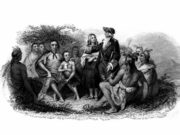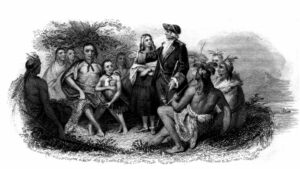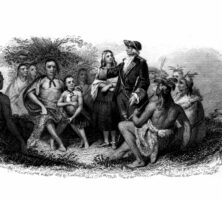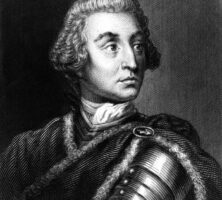As visionary, social reformer, and military leader, James Oglethorpe conceived of and implemented his plan to establish the colony of Georgia. It was through his initiatives in England in 1732 that the British government authorized the establishment of its first new colony in North America in more than five decades. Later that year he led the expedition of colonists that landed in Savannah early in 1733. Oglethorpe spent most of the next decade in Georgia, where he directed the economic and political development of the new colony, defended it militarily, and continued to generate support and recruit settlers in England and other parts of Europe.

James Edward Oglethorpe was born on December 22, 1696, in London, England; he was the tenth and last child of Eleanor and Theophilus Oglethorpe. Though frequently in London, the Oglethorpes maintained a large family estate in Godalming, a small Surrey town near London. Here at Westbrook Manor (later the Meath Home) young Oglethorpe grew up. His father owned other property in Godalming and the neighboring town of Haslemere, and the rent from these gave the Oglethorpes a comfortable life. Both Theophilus and Eleanor had long been interested in politics, and in 1698 voters of Haslemere elected Theophilus to the House of Commons. All three of his sons—including Oglethorpe—would later hold this seat.
Little is known about Oglethorpe’s boyhood, but in 1714 he was admitted to Corpus Christi College at Oxford University. The excitement of Europe’s defense against the advancing Turks led him to drop out of school to enroll in a military academy in France. He subsequently traveled to Austria, where he became an aide to Prince Eugene of Savoy. After a victorious campaign against the Turks, Oglethorpe returned to England, where he reentered Corpus Christi. Although he never graduated, the college did award him a special M.A. in 1731.

After a brief sojourn with academics, Oglethorpe returned to Godalming. In 1722 he successfully ran for Parliament, occupying a seat in the House of Commons previously held by his father and two older brothers. Here Oglethorpe devoted his energies to Britain’s national and international interests.
Prison Reform
In 1729 James Oglethorpe’s life was to change. The previous year, one of his friends, Robert Castell, was jailed in London’s Fleet Prison because of his debts. At the time, inmates were forced to pay prison staff fees for decent room and board. Unable to pay, Castell was thrown into a cell with a prisoner who had smallpox. Castell’s death from the disease led Oglethorpe to launch a national campaign to reform England’s prisons. Named chairman of a parliamentary committee to investigate the jails, Oglethorpe saw firsthand the horrible conditions, abuses, and extortion prisoners faced. He also was alarmed that so many British citizens faced jail for no other reason than indebtedness.
As a result of the investigation a number of steps were taken to reform London’s prisons. Oglethorpe’s efforts to expose and correct prison abuses gained him national attention, and he became widely regarded as one of Britain’s most active humanitarians. Prison reform did not, however, solve the plight of the large number of poor people in England. Oglethorpe and several colleagues from the jails committee, notably John Lord Viscount Percival (later the first earl of Egmont), began exploring the possibility of creating a new colony in America. They believed that if given a chance, England’s “worthy poor” could be transformed into farmers, merchants, and artisans. But strict rules would be needed to prevent the class divisions that plagued English society. Thus, all the settlers would work their own land, with slavery and large landholdings specifically prohibited.
Georgia’s Founding
Although charity had been the initial motivation for the Georgia movement, by 1732 military and economic considerations were the principal factors. As a result of Oglethorpe’s persuasive arguments, King George II in 1732 granted a charter for creating Georgia and named Oglethorpe as one of twenty-one Trustees to govern the new colony.
As the Trustees began interviewing potential colonists, they looked for carpenters, tailors, bakers, farmers, merchants, and others with the skills necessary for the colony’s success. By this time any ideas of Georgia’s being a haven for debtors in English prisons had long vanished—and not one formerly jailed debtor was among the first colonists selected. Georgia’s founders thought that the colony’s climate would be suitable to the production of valuable silk, wine, and other Mediterranean-type commodities. The Trustees imagined the colony as a place where settlers could achieve a comfortable living rather than an enormous personal fortune, which was associated with plantation life in other parts of British America.
In November 1732 a total of 114 men, women, and children gathered at Gravesend on the River Thames to set sail for the new colony of Georgia. Oglethorpe understood that Georgia’s charter prohibited him from holding office, owning land, or receiving a salary in the new colony, yet he gave up the comforts of home to accompany the first boatload of Georgia settlers.
After several delays they boarded the Anne for a two-month journey across the Atlantic. Following a brief visit in Charleston, the colonists proceeded to Port Royal, South Carolina’s southernmost outpost. While they rested, Oglethorpe and a band of Carolina Rangers went ahead to look for a place to settle. Some seventeen miles inland from the mouth of the Savannah River, they found Yamacraw Bluff overlooking the south bank of the river. Oglethorpe immediately struck up a friendship with the Yamacraw chief, Tomochichi, thus beginning a long and close relationship between the two.
On February 12, 1733, Oglethorpe returned to Yamacraw Bluff with the Georgia colonists. With the help of militia and enslaved African Americans from South Carolina, the pine forest was quickly cleared, and Oglethorpe laid out a plan for the new town of Savannah. His distinctive pattern of streets, ten-house “tythings,” and public squares soon became a reality. Identical clapboard houses built on identical lots, plus restrictions on how much land could be owned and an outright prohibition on slavery, were testimony to the Trustees’ desire to produce a classless society—one in which each head of household worked his own land. This egalitarian ideal was not fully realized, however, in that women were not allowed to own land in the new colony. The Trustees based this policy on the assumption that each plot of land requried a male worker (and armed defender).

Leadership in the New Colony
Living up to the motto of Georgia’s Trustees—Non sibi sed aliis (Not for self, but for others)—Oglethorpe worked tirelessly on behalf of the colony during the initial months. Sometimes violating Trustee policy, Oglethorpe permitted Jews, Lutheran Salzburgers, and other persecuted religious minorities to settle in Georgia. On the matter of importing enslaved Africans from any source, Oglethorpe never wavered in wholly opposing slavery in Georgia. With respect to Georgia’s Indians, he had an enlightened policy, always respecting their customs, language, and needs. Land cessions were always agreed to by treaty according to proper Indian custom. Also, Oglethorpe actively sought to protect the Indians from unscrupulous white traders.

Oglethorpe had come to Georgia with no formal title other than Trustee. Although he could not hold office, Oglethorpe was clearly the leader of the colony, subject to instructions and rules promulgated by the Trustees back in London. In recognition of his role, he is almost universally regarded as Georgia’s first governor.
Despite its charitable origins, Georgia was also a military buffer designed to protect Britain’s southern colonies. As the Spanish military presence in St. Augustine, Florida, grew, Oglethorpe’s dream that Georgia would become an ideal agrarian society began to fade. The threat of invasion heightened, and Oglethorpe focused his efforts on the defense of Georgia. Because support from the Trustees and Parliament had never been sufficient, Oglethorpe had mortgaged his landholdings back in England to finance the colony’s needs. Although he hoped that Parliament would repay his rising debts, he fully realized that he could lose everything. Oglethorpe believed in the cause of Georgia—and as long as he had anything that he could mortgage to raise money for the colony, he was not going to give up.
Military Leadership
Oglethorpe returned to London on several occasions to lobby the Trustees and Parliament for funding to build forts in Georgia. During a visit in 1737 Oglethorpe convinced King George II to appoint him as a colonel in the army and give him a regiment of British soldiers to take back to Georgia. Interestingly, Oglethorpe was a civilian at this time, with only limited military experience (primarily as an aide to Prince Eugene). Nevertheless, he got what he wanted: rank in the regular army and a regiment. Oglethorpe also was given the title of “General and Commander in Chief of all and singular his Majesty’s provinces of Carolina and Georgia.” This has led to confusion as to whether Oglethorpe was now a colonel or a general. In terms of military rank in the British army, he was a colonel. During the pending hostilities with Spain, however, Oglethorpe also held a brevet (or temporary) field commission as general in order to command all allied forces (Carolina Rangers, Indian allies, etc.). Only in September 1743, however, was Oglethorpe actually promoted to the rank of brigadier general in the British army.

After the War of Jenkins’ Ear erupted in 1739, Oglethorpe was ready to take the initiative. In 1740 he assembled an invasion force consisting of his regiment, Indian allies, Carolina Rangers, and several ships in the Royal Navy. His goal was the Spanish fortress at St. Augustine. Unfortunately, the siege failed and the allied force fell apart, forcing a dejected Oglethorpe back to St. Simons Island to await the Spanish counterattack that would surely follow.
The Spanish invasion of Georgia came in July 1742. Ships bearing thousands of Spanish troops landed on the south end of St. Simons Island. Back at Fort Frederica, which was still under construction, Oglethorpe rallied his forces for battle. In a critical skirmish known as the Battle of Gully Hole Creek, Oglethorpe’s forces turned back a Spanish advance force. As they pursued the retreating Spaniards down the trail, Oglethorpe halted his force at the edge of a marsh. Here he positioned his men to await the counterattack by the main Spanish army. Oglethorpe then took temporary leave of his force to return to Fort Frederica, which he feared was under naval attack. Finding no such assault underway, Oglethorpe left to rejoin his men at the marsh. Meanwhile, Spanish troops had already arrived but were turned back after a brief but fierce fight. Ironically, Oglethorpe arrived just after the conclusion of what would become known as the Battle of Bloody Marsh. This loss helped persuade Spanish commanders to withdraw to St. Augustine. Never again would Spanish forces mount an offensive against Britain’s colonies on the East Coast of America. As a result, Oglethorpe was a national hero in England, and King George II promoted him to brigadier general in His Majesty’s Army.
Return to England
In 1743 Oglethorpe led one more unsuccessful attempt to take the Spanish fortress at St. Augustine. While he pondered his future, Oglethorpe suddenly received word that he had to return to London. After the Florida invasion an unhappy officer in his regiment had made some serious allegations of misconduct against Oglethorpe, and the War Office in London wanted the general to answer those charges. Also, Oglethorpe needed Parliament to repay him for his substantial personal loans on Georgia’s behalf.
In 1744 a special board of general officers discharged all allegations that had been made against the general. That same year Parliament voted to reimburse Oglethorpe—so both his honor and fortune had been preserved.
To this point Oglethorpe had lived his life almost solely for others, but that was to change. In London the popular hero met Elizabeth Wright, a recent heiress. They married in September 1744 and settled at Cranham Hall, her inherited estate in the small Essex town of Cranham, seventeen miles east of London.
Much of their social life was spent in London, where Oglethorpe became friends with Samuel Johnson, James Boswell, Oliver Goldsmith, and other well-known men and women of the time. In 1745 Oglethorpe resumed his military career after the invasion of forces attempting to place the Stuart Pretender, Bonnie Prince Charlie, on the British throne. He was ordered to take a force to the north of England to engage the invaders, but because of controversy centering upon his strategy in the campaign, Oglethorpe was subjected to a court martial. Once again, he was totally exonerated.

Oglethorpe continued to serve on the Board of Trustees of Georgia. Despite his opposition, however, the Trustees gradually relaxed their restrictions on land ownership, inheritance, rum, and slavery. As a result, the general’s attendance on the board declined. By 1750 Georgia’s founder was no longer involved with the board at all. The grand experiment was over, and the few remaining Trustees voted to return their charter to govern Georgia, which subsequently became a royal colony.
Oglethorpe remained in Parliament until 1754, when he was defeated in a bid for reelection. Eventually he became the senior general in the British army, but never again would he serve on active duty (though there is a popular legend that with the outbreak of the American Revolution [1775-83], Oglethorpe was asked to command a British force—an offer he declined). The general did have one final experience on the field of battle. In the 1750s he left England quietly to fight in Europe with his old friend Field Marshal James Keith in the Seven Years’ War (1756-63). Because of possible implications of a British general’s involvement in a war against France, however, Oglethorpe served under fictitious names.
Later Life
Oglethorpe returned to England in 1760 to live the life of a gentleman. He and Elizabeth divided their time between their country estate and their London town house on Lower Grosvenor Street. Though they never had children, by all accounts James and Elizabeth enjoyed an active social life entertaining friends and many of the literary and artistic figures of the day.
Oglethorpe eventually lived to see the colony that he founded become part of the United States of America. Though the historical record is silent as to how he felt about the American Revolution, it is known that on June 4, 1785, Oglethorpe met with John Adams, the first U.S. ambassador to Great Britain, and expressed “great esteem and regard for America.”
After a brief illness Oglethorpe died on June 30, 1785—just six months shy of his eighty-ninth birthday. He was buried in a vault beneath the chancel floor of the Parish Church of All Saints, which stands immediately adjacent to Cranham Hall. Upon her death two years later, Elizabeth was interred in the same tomb.
Georgians still remember James Edward Oglethorpe in many ways. His name adorns Oglethorpe County, two towns (including Oglethorpe), Oglethorpe University, and numerous schools, streets, parks, and businesses. In paying tribute to Oglethorpe, however, Georgians can perhaps best honor his memory by remembering him as a man who wouldn’t quit and who lived by the simple but profound philosophy that life is not about self, but about others.



















